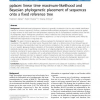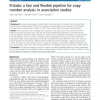8125 search results - page 1614 / 1625 » Parallelism and evolutionary algorithms |
ISMB
2000
13 years 8 months ago
2000
Mycobacterium tuberculosis (M. tb.) strains differ in the number and locations of a transposon-like insertion sequence known as IS6110. Accurate detection of this sequence can be ...
ECCV
2010
Springer
13 years 7 months ago
2010
Springer
Abstract. Multiple-instance learning (MIL) allows for training classifiers from ambiguously labeled data. In computer vision, this learning paradigm has been recently used in many ...
BMCBI
2010
13 years 6 months ago
2010
Background: Likelihood-based phylogenetic inference is generally considered to be the most reliable classification method for unknown sequences. However, traditional likelihood-ba...
BMCBI
2010
13 years 6 months ago
2010
Background: Genome-wide association studies (GWAS) using Copy Number Variation (CNV) are becoming a central focus of genetic research. CNVs have successfully provided target genom...
BMCBI
2008
13 years 6 months ago
2008
Background: Solexa/Illumina short-read ultra-high throughput DNA sequencing technology produces millions of short tags (up to 36 bases) by parallel sequencing-by-synthesis of DNA ...


